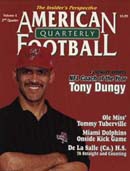AMERICAN FOOTBALL MONTHLY THE #1 RESOURCE FOR FOOTBALL COACHES
Article CategoriesAFM Magazine
|
Texas Tech's Double Screenby: Rick DykesOffensive Coordinator,Texas Tech University © More from this issue One of the biggest advantages an offense can have in a game is an ability to keep the opposing defense off balance. At Texas Tech, we try to gain such an advantage in a variety of ways. One of our main goals is to mix the running game with the passing game using a large variety of formations. Another of our biggest weapons on offense is our screen game. I would like to talk about one of our most successful and unique screen passes. We call this play "Double Screen." Double Screen has been one of our most consistent plays over the past few seasons. We have averaged over eight yards a call for the last four years. The major advantage that contributes to the success of the play is that it gives the QB has three options to go to. We rarely have a bad play since one of the options is usually open.
| 
|
Subscribe now to start receiving our monthly magazine PLUS get INSTANT unlimited access to over 4000 pages of 100 percent football coaching information, ONLY available at AmericanFootballMonthly.com! | |||
NEED PASSWORD HELP |




